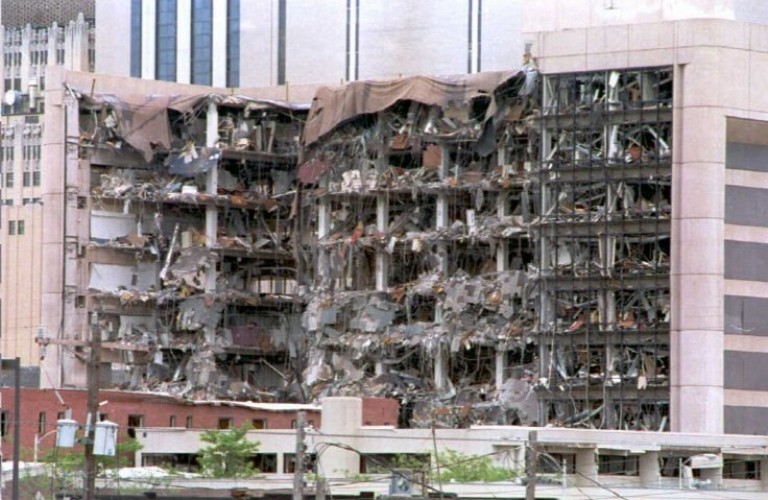The Salvation Army Remembers: April 19, 1995
Cynthia (Cindy) Fuller | cindy_fuller@uss.salvationarmy.org

April 19, 1995 (Oklahoma City, OK) For Oklahomans, and many across the United States and World, April 19, 1995 will always be remembered as the darkest day in Oklahoma’s 108 year history. The bombing of the Murrah Federal Building forever changed the lives of the families and friends of the 168 men, women and children who were killed. With the twentieth anniversary of the bombing today, The Salvation Army reflects on that day as well as the following days.
Major Marshall Gesner recalls the emotional impact of the ruined building when he saw it after arriving on the scene about 30 minutes after he heard the explosion. Gesner states “I have always thought it looked exactly as though a huge paw had simply clawed half the building away.”
As Gesner continues with his recollection, he remembers the tremendously effective and coordinated response of everyone involved from Governor and Mrs. Keating down to the individual fireman, policeman, truck driver, crane operator, canteen worker and more. He and all involved are especially proud of the well-coordinated Salvation Army effort throughout the response and recovery phases. There was effective involvement of Salvation Army personnel from all four territories, obtained through the concentrated leadership efforts of Major Robert Tritton, Divisional Commander (1995), and the Divisional Staff, as well as officers, employees and volunteers from the Oklahoma City Area Command and throughout the Arkansas/Oklahoma Division who bore the brunt of the work in the initial response.
Within 40 minutes, the Oklahoma City Command had two mobile feeding and response units on site, prepared to serve. In approximately two hours from that time, two other units from Tulsa and Ada responded and were on site. The Salvation Army deployed seven mobile feeding units to the site, in total. In the aftermath of the bombing, The Salvation Army provided over 100,000 meals and provided over 100,000 ponchos, gloves, hardhats and knee pads to rescue workers.
The mission of The Salvation Army, in times of crisis, is to provide physical and spiritual relief and comfort to victims of the tragedy, as well as to serve rescuers and workers involved in the response/recovery operation. This includes mobile feeding units supplying routine refreshments, as well as standard meals. Additionally, provisions are made for counseling and spiritual guidance, a conduit for requested supplies and materials, financial managerial casework assistance for victims and their relatives, and other general support activity, as requested. The Salvation Army operated three mobile Social Services offices and provided personnel in cooperation with FEMA at the Recovery Service Center.
Emotional and spiritual care was provided to families, rescue workers and even our own responders. The Salvation Army officers played a key role in coming alongside the families of the victims for several weeks after the disaster, along with police and fire chaplains and Seventh Day Adventists ministers. These officers comprised one of the largest single component of ministers who were actually on site the Sunday the families were allowed to visit. For Gesner, that is another day all will remember, thanking God again for allowing us to serve by guiding and blessing our efforts.
What arose that day became known as the “Oklahoma Standard.” Twenty years after the bombing, the nation continues to see Oklahomans characterize this standard by banding together during trying times and continuing to see hope. Oklahomans remember. The Salvation Army remembers. The Salvation Army will never forget. May all remember and continue to pray for Oklahoma, the families and friends who lost loved ones on April 19, 1995.
For more information or to provide financial support so The Salvation Army can continue to provide support during times of disaster, visit The Salvation Army’s website at www.salvationarmyusa.org or call 1-800-SAL-ARMY. For additional information on disaster response, visit www.disaster.salvationarmyusa.org.
The Salvation Army: The Salvation Army, an evangelical part of the universal Christian church established in 1865, has been supporting those in need in His name without discrimination for 130 years in the United States. Nearly 30 million Americans receive assistance from The Salvation Army each year through the broadest array of social services that range from providing food for the hungry, relief for disaster victims, assistance for the disabled, outreach to the elderly and ill, clothing and shelter to the homeless and opportunities for underprivileged children. 82 cents of every dollar spent is used to carry out those services in 5,000 communities nationwide. For more information, go to www.salvationarmyusa.org.
About The Salvation ArmyThe Salvation Army annually helps more than 30 million Americans overcome poverty, addiction, and economic hardships through a range of social services. By providing food for the hungry, emergency relief for disaster survivors, rehabilitation for those suffering from drug and alcohol abuse, and clothing and shelter for people in need, The Salvation Army is doing the most good at 7,600 centers of operation around the country. In the first-ever listing of “America’s Favorite Charities” by The Chronicle of Philanthropy, The Salvation Army ranked as the country’s largest privately funded, direct-service nonprofit. For more information, visit www.SalvationArmyUSA.org. Follow us on Twitter @SalvationArmyUS and #DoingTheMostGood.